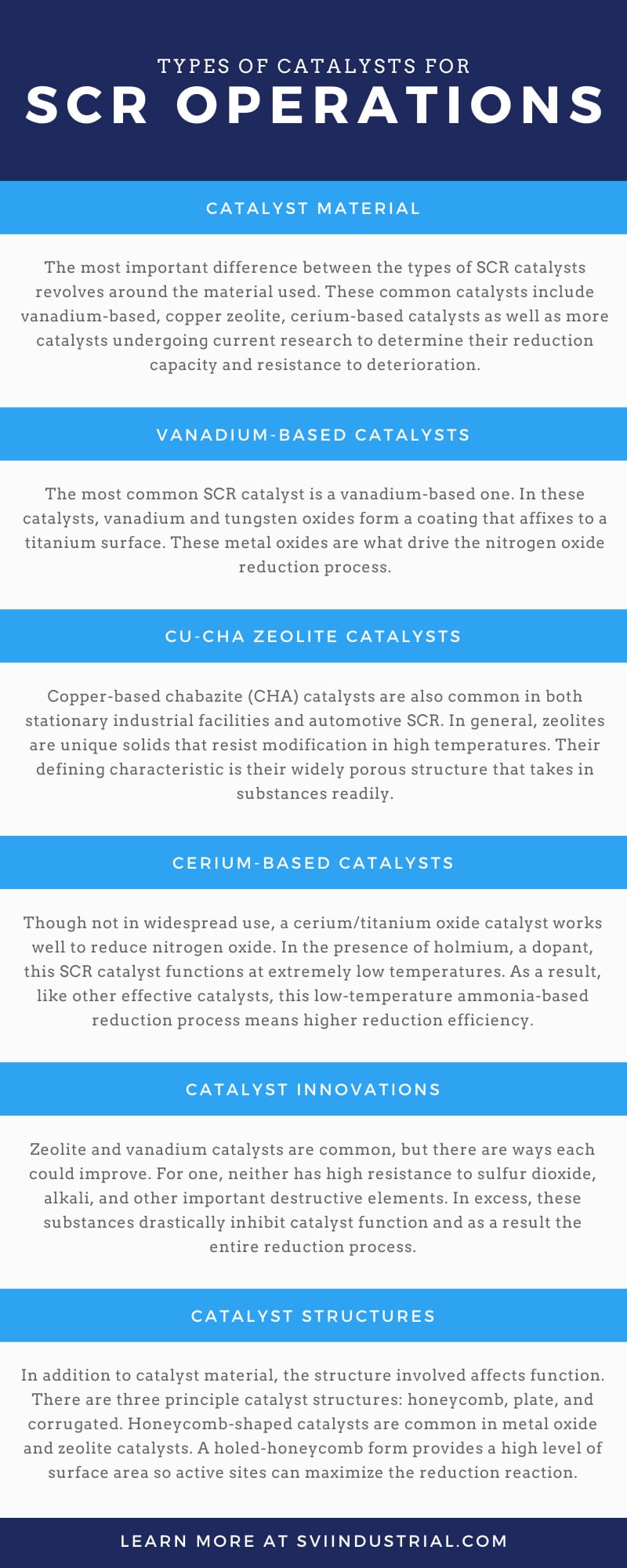
Written by Scott Schreeg | Technical
Nitrogen oxides, or NOx, are common pollutants that produce a bevy of harmful environmental effects. They, along with sulfur dioxide and other particles, form acid rain that damages many animals’ habitats. Also, nitrogen oxides are one of several elements in smog, which damages humans’ respiratory systems and contributes to the uptick in asthma rates over the last couple of decades. While a significant amount of nitrogen oxides comes from automobiles, industrial power plants are also responsible for NOx creation.
To limit the emission of nitrogen oxides from these plants, engineers implement one or several chemical NOx reduction methods. These interventions occur either during combustion or post-combustion and prevent NOx formation or convert already produced nitrogen oxides into an inert substance.
Two of the possible post-combustion techniques are selective catalytic reduction (SCR) and selective non-catalytic reduction (SNCR). Both take existing NOx and introduce ammonia in a heated environment so a reaction occurs that creates harmless nitrogen gas and water vapor. The difference lies in the use or absence of a catalyst. SNCR, as the name implies, doesn’t involve a catalyst, while SCR does. A catalyst does the vital work of aiding a chemical reaction to completion without necessitating high temperatures to do so. It’s important to keep in mind that a catalyst is not a reactant but rather a substance that speeds up a reaction without being consumed. These catalysts make SCR implementations so effective because the lower the temperatures, the higher the NOx reduction rate.
The catalysts used in selective catalytic reduction vary some, and there is research on potential improvements to conventional catalysts. These variations, whether in catalyst substance or shape, are noteworthy—to learn more, read this guide to the different types of catalysts for SCR operations and how to maintain them.
Catalyst Material
The most important difference between the types of SCR catalysts revolves around the material used. These common catalysts include vanadium-based, copper zeolite, cerium-based catalysts as well as more catalysts undergoing current research to determine their reduction capacity and resistance to deterioration.
Vanadium-Based Catalysts
The most common SCR catalyst is a vanadium-based one. In these catalysts, vanadium and tungsten oxides form a coating that affixes to a titanium surface. These metal oxides are what drive the nitrogen oxide reduction process. For example, one common SCR setup involves vanadium pentoxide (V2O5) and tungsten trioxide (WO3) on a titanium dioxide (TiO2) surface. When ammonia nears the vanadium catalyst, the vanadium pentoxide readily absorbs the ammonia and NO reacts while in the gas phase.
Cu-CHA Zeolite Catalysts
Copper-based chabazite (CHA) catalysts are also common in both stationary industrial facilities and automotive SCR. In general, zeolites are unique solids that resist modification in high temperatures. Their defining characteristic is their widely porous structure that takes in substances readily. In fact, the word zeolite directly translates to “boiling stone,” a nod to their long-term receptivity to water and the solid’s appearance when heated. Businesses commonly use zeolites to capture unwanted molecules.
Copper-based catalysts, specifically Cu-SSZ-13 and Cu-SAPO-34, are effective means of NOx reduction for several reasons. For one, reduction with copper-based zeolites can take place at low temperatures compared to several other catalysts, thus increasing reduction efficiency. Additionally, copper zeolites have many Brønsted acid sites, which allow for significant NOx reduction. One thing to consider about zeolite catalysts is their pore structures are variable. These zeolite SCR candidates include “large and medium pore zeolites like ZSM-5, MOR, FER, [and] BEA and small pore zeolites like SSZ-13 and SAPO-34,” all of which operate under different conditions.
Cerium-Based Catalysts
Though not in widespread use, a cerium/titanium oxide catalyst works well to reduce nitrogen oxide. In the presence of holmium, a dopant, this SCR catalyst functions at extremely low temperatures. As a result, like other effective catalysts, this low-temperature ammonia-based reduction process means higher reduction efficiency.
Catalyst Innovations
Zeolite and vanadium catalysts are common, but there are ways each could improve. For one, neither has high resistance to sulfur dioxide, alkali, and other important destructive elements. In excess, these substances drastically inhibit catalyst function and as a result the entire reduction process. For this reason, there are several potential catalyst alternatives engineers are examining. These include metal oxides with manganese or iron bases, vandate acidic catalysts, new zeolite catalysts also utilizing iron and manganese, monolith catalysts and more.
Catalyst Structures
In addition to catalyst material, the structure involved affects function. There are three principle catalyst structures: honeycomb, plate, and corrugated. Honeycomb-shaped catalysts are common in metal oxide and zeolite catalysts. A holed-honeycomb form provides a high level of surface area so active sites can maximize the reduction reaction. Meanwhile, a plate structure is the second most common SCR structure. Plate structures, when finished, are blocklike structures with high levels of surface area between sheets of metal that form the block where engineers apply catalysts. Plate catalysts are sometimes more effective than honeycomb because there is a lower risk of the catalyst plugging up and the reactants losing access to the catalyst. Corrugated is the final, least common catalyst structure. This involves fluted pieces of ceramic or metal between flat pieces and also allows for high levels of surface area. Regardless of the structure, layering your catalyst directly increases your nitrogen oxide reduction.
Problems With Catalysts
When maintaining any of the various kinds of catalysts, it’s important to keep in mind these universal tips to maintain efficiency.
Ash Blocks Active Sites
First, because post-combustion SCR deals with rapidly moving exhaust substances, there is a high risk of active sites being restricted from reactants by ash. Ammonia-sulfur salts and particulate matter in particular deposit on catalysts and prevent the ammonia-nitrogen oxide reaction from taking place. Soot blowers are a common method for removing ash and other material deposits.
Thermal Sintering
Also, thermal sintering changes the surface area of a catalyst and limits total reduction. Practically, sintering involves high temperatures causing non-catalytic sections of the catalyst to grow. Tungsten limits sintering when included in a catalyst.
Alkaline Metal Complications
Alkaline metals also pose a threat to catalysts. These metals may react with the catalyst to change its structure. Once chemically changed, that part of the catalyst is no longer active. Also, calcium oxide can react to poison the catalyst and prevent the reactants from properly meeting the catalyst.
If you’re an engineer looking to adjust your selective catalytic reduction process, consider contacting SVI Dynamics. We back every SCR system install with our years of industry experience and care for our customers and their operations.

